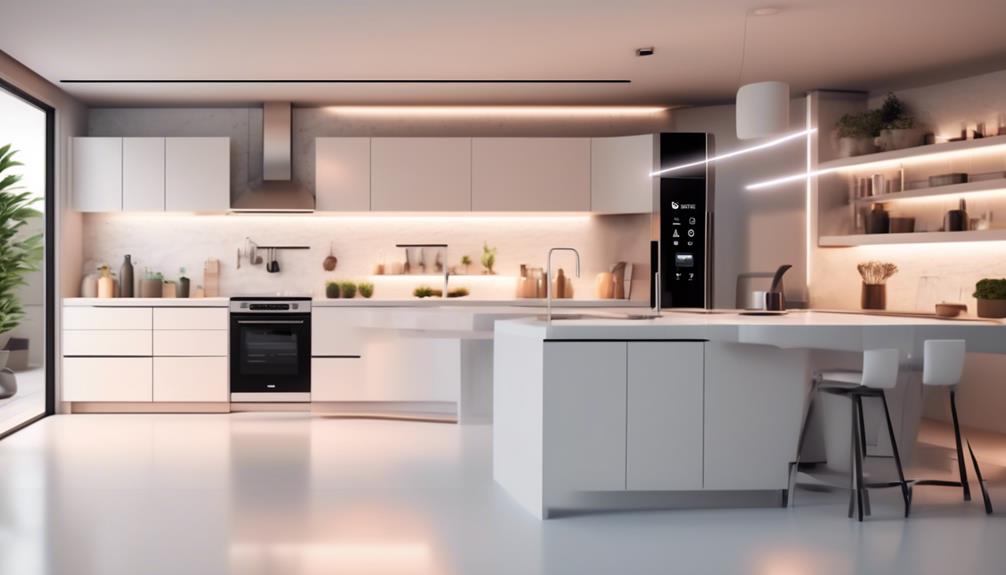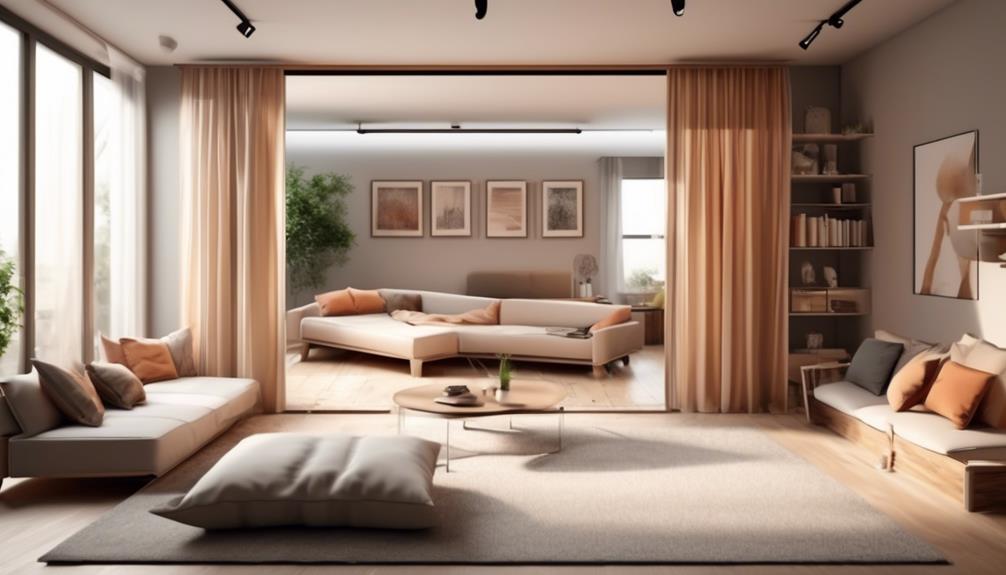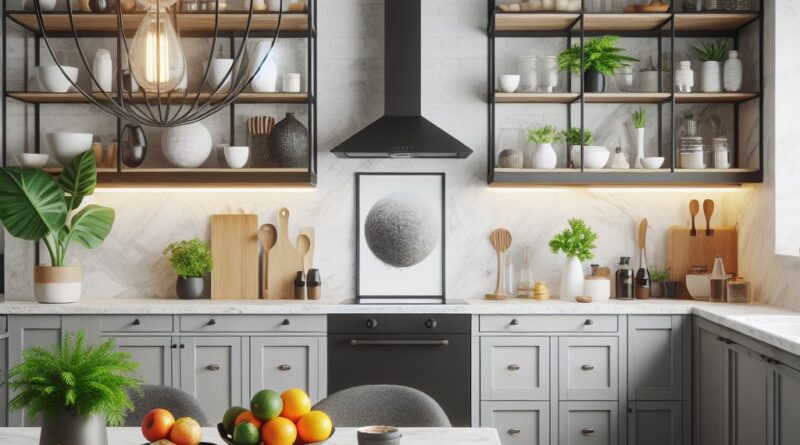What Are the Latest Home Improvement Trends?
This post may contain affiliate links which means I may receive a commission for purchases made through links. As an Amazon Associate, I earn from qualifying purchases. Learn more on my Private Policy page.
Step into the world of home improvement trends, where the landscape is constantly shifting like the ebb and flow of a river. In a market that’s always evolving, it’s essential to stay ahead of the curve and be in the know about the latest innovations shaping our living spaces.
From the integration of smart home technology to the revival of vintage and retro elements, there’s a myriad of trends that are reshaping the way we think about home design. But what exactly are these trends, and how can they transform your living space into a modern haven that reflects your style and values?
Smart Home Technology Integration

Integrating smart home technology into your living space can enhance convenience, security, and energy efficiency. Energy-efficient appliances are a key component of a smart home. These appliances are designed to consume less energy while performing at their best. By investing in energy-efficient appliances, you not only contribute to a greener environment but also save on your utility bills.
Automated security is another crucial aspect of smart home technology. With automated security systems, you can remotely monitor your home, receive real-time alerts, and even control access to your property from anywhere. This provides peace of mind and ensures that your home is always secure.
Voice-controlled lighting is a popular feature of smart home automation. With voice commands, you can adjust the lighting in your home without having to get up or use a switch. This not only adds a layer of convenience but also contributes to energy efficiency by allowing you to easily turn off lights in unoccupied rooms.
Smart home automation, in general, allows you to control various aspects of your home, such as temperature, entertainment systems, and even kitchen appliances, all from a single device or through voice commands.
Incorporating these smart technologies into your home can significantly improve your daily life while also reducing your environmental impact.
Sustainable and Eco-Friendly Materials
Choosing sustainable and eco-friendly materials for your home improvement projects can positively impact the environment and contribute to a healthier living space for you and your family. Sustainable building practices involve using materials that have a lower environmental impact, such as reclaimed wood, bamboo, cork, and recycled metal. These materials not only reduce the strain on natural resources but also often have lower levels of harmful chemicals, improving indoor air quality and creating a safer environment for your family.
When it comes to eco-friendly decor, consider using non-toxic paints and finishes that are low in volatile organic compounds (VOCs). These paints aren’t only better for the environment but also healthier for you and your family. Additionally, incorporating energy-efficient appliances and fixtures can further reduce your home’s environmental footprint and save you money on utility bills in the long run.
Incorporating sustainable and eco-friendly materials into your home improvement projects can also add a unique and stylish touch to your living space. Reclaimed wood can bring warmth and character to your home, while bamboo flooring offers durability and a modern aesthetic. Furthermore, using recycled materials in your decor can be a conversation piece and showcase your commitment to sustainability.
Multifunctional and Flexible Spaces

Consider incorporating multifunctional and flexible spaces into your home design to maximize functionality and adaptability. Creating versatile areas within your home can enhance your living experience and make the most of your available space.
Here are some key trends to consider when designing multifunctional and flexible spaces:
- Space saving furniture: Invest in furniture pieces that serve multiple purposes, such as a sofa with built-in storage or a coffee table that can be converted into a dining table. These innovative furniture options can help you make the most of limited space while maintaining a stylish and organized home.
- Versatile room layouts: Embrace the concept of open floor plans and modular furniture to allow for seamless transitions between different activities within a single space. This approach encourages creativity and practicality, enabling you to adapt your home to various needs, whether it’s hosting a gathering or creating a cozy reading nook.
- Convertible workspaces: With the increasing popularity of remote work, consider creating a workspace that can easily transform into a different function when not in use. For example, a fold-down desk in the living room or a hidden office nook in the bedroom can provide a dedicated work area without sacrificing valuable space.
- Multi-purpose rooms: Design rooms that can serve multiple functions, such as a guest bedroom that doubles as a home office or a dining room that can be used for entertaining and as a study area. This trend allows you to optimize your home’s square footage and adapt to changing needs without compromising on comfort and style.
Biophilic Design and Indoor Greenery
To enhance the adaptability of your home, embrace the incorporation of biophilic design and indoor greenery, fostering a seamless connection between the indoors and nature.
Natural light plays a crucial role in biophilic design, as it not only brightens up the space but also creates a link to the outdoors. Consider maximizing natural light by strategically placing windows and using sheer curtains to allow sunlight to filter through. This can create a warm and inviting atmosphere while reducing the need for artificial lighting.
Incorporating plant walls is another way to bring the outdoors in and elevate the biophilic design of your home. Plant walls not only add a stunning visual element but also purify the air and contribute to a healthier indoor environment. Consider installing vertical plant walls in areas with ample natural light to create a striking focal point that brings nature into your living space.
Indoor greenery, such as potted plants and hanging planters, can be strategically placed throughout your home to infuse a sense of tranquility and freshness. Choose plants that thrive indoors and are low-maintenance to effortlessly integrate greenery into your living spaces.
Wellness and Health-Centered Features

Enhance your living space with wellness and health-centered features that promote a balanced and rejuvenating environment. Creating a home that prioritizes wellness can significantly impact your overall quality of life.
Here are four current trends to integrate wellness and health-conscious design into your living space:
- Wellness Retreat Areas: Designate a specific area in your home for relaxation and rejuvenation. This could be a cozy nook with comfortable seating, soft lighting, and calming decor, or even a dedicated yoga or meditation space. Having a designated wellness retreat area can provide a peaceful sanctuary within your home where you can unwind and de-stress.
- Air Purification Systems: Invest in advanced air purifiers to ensure that the air you breathe indoors is clean and free of pollutants. Look for systems that filter out allergens, dust, and toxins, promoting better respiratory health and overall well-being.
- Biophilic Elements: Incorporate elements of nature into your home, such as indoor plants, natural materials, and nature-inspired artwork. Biophilic design has been shown to reduce stress, improve cognitive function, and enhance overall mood and productivity.
- Healthy Lighting Solutions: Integrate lighting that mimics natural daylight to regulate your circadian rhythm and promote better sleep. Consider adjustable lighting options that allow you to control the intensity and color temperature, creating a healthier and more balanced indoor environment.
Vintage and Retro Revival
Embrace the vintage and retro revival trend to infuse your living space with nostalgic charm and timeless style. Incorporating elements such as vintage clothing, antique furniture, retro music, and classic movies can effortlessly add character and personality to your home.
When it comes to vintage clothing, consider displaying a few timeless pieces as decor. A well-preserved vintage dress or a stylish fedora can serve as unique and eye-catching accents.
Additionally, antique furniture pieces can bring a sense of history and elegance to any room. Look for timeless pieces such as a distressed wooden cabinet or a vintage chaise lounge to create a cozy and inviting atmosphere.
Incorporating retro music and classic movies into your home entertainment system can also contribute to the vintage and retro revival trend. Consider setting up a designated area for your vinyl record player and collection of classic albums. This can serve as both a decorative element and a source of entertainment.
Displaying vintage movie posters or creating a gallery wall with classic film memorabilia can also add a touch of retro charm to your space.
Minimalist and Scandinavian Influences

Infuse a sense of simplicity and functionality into your living space by drawing inspiration from minimalist and Scandinavian influences after embracing the vintage and retro revival trend.
Here are four ways to incorporate minimalist and Scandinavian influences into your home:
- Clean Lines: Opt for furniture with clean lines and simple designs. Minimalist decor focuses on essential elements, so choose pieces with sleek silhouettes and minimal ornamentation to create a clutter-free environment.
- Neutral Colors: Embrace a neutral color palette with pops of muted tones to achieve a Scandinavian-inspired look. White, gray, and light wood tones can help create a bright and airy atmosphere, while adding a cozy touch to your space.
- Functional Furnishings: Invest in multi-functional furniture pieces that serve a purpose while maintaining a minimalist aesthetic. Scandinavian furniture often features practical designs with integrated storage solutions, perfect for optimizing space in smaller homes.
- Natural Elements: Incorporate natural materials such as wood, leather, and stone to bring warmth and texture to your living space. Scandinavian design emphasizes the use of natural elements to create a harmonious and inviting environment.
Bold Colors and Statement Pieces
Consider incorporating bold colors and statement pieces to revitalize your living space and infuse it with personality and vibrancy. Vibrant hues can breathe new life into your home, creating a lively and energetic atmosphere. Dare to experiment with bold shades such as deep emerald greens, rich sapphire blues, and fiery reds to make a striking impact in any room. These colors can be incorporated through accent walls, furniture, or decorative accessories, instantly transforming the ambiance of your space.
Artistic accents are another way to introduce bold colors and statement pieces into your home. Consider incorporating eye-catching artwork, unique sculptures, or bold patterns in your decor. These elements can serve as conversation starters and focal points, adding a touch of individuality to your living space. Additionally, statement pieces such as a bold, geometric rug or a striking chandelier can become the centerpiece of a room, tying the entire space together with flair and personality.
When integrating bold colors and statement pieces into your home, it’s important to strike a balance. Pair bold hues with neutral tones to create a cohesive look that doesn’t overwhelm the space. Additionally, consider the overall style and aesthetic of your home to ensure that the bold elements complement the existing decor.
Frequently Asked Questions
How Can I Incorporate Smart Home Technology Into My Existing Home Without a Complete Renovation?
You can easily incorporate smart home technology into your existing home without a complete renovation. Retrofitting smart automation is budget-friendly and boosts energy efficiency. Start with smart thermostats, lighting, and security systems for a seamless upgrade.
What Are Some Creative Ways to Bring Biophilic Design and Indoor Greenery Into a Small Apartment or Urban Living Space?
To bring biophilic design and indoor greenery into small urban spaces, consider hanging planters, vertical gardens, and terrariums. Utilize natural materials, such as wood and stone, and incorporate plants that thrive in low light conditions.
Are There Any Sustainable and Eco-Friendly Materials That Are Particularly Well-Suited for Outdoor Home Improvement Projects?
When it comes to outdoor projects, sustainable materials and eco-friendly options are essential. Look into recycled composite decking for a durable, low-maintenance option. For landscaping solutions, consider permeable pavers to help with water drainage and reduce runoff.
What Are Some Innovative Ways to Incorporate Wellness and Health-Centered Features Into a Home Design, Beyond Just Adding a Gym or Yoga Studio?
To create a wellness-centered home design, consider incorporating wellness lighting, air-purifying decor, natural material accents, and tranquil water features. These elements can promote a serene and healthy living environment, fostering overall well-being beyond just a gym or yoga studio.
How Can I Incorporate Bold Colors and Statement Pieces Into My Home Without Overwhelming the Space or Clashing With Existing Decor?
To incorporate bold colors and statement pieces into your home without overwhelming the space or clashing with existing decor, try these tips and tricks: focus on color coordination and add stylish accents to balance the look.
Conclusion
In conclusion, staying up to date with the latest home improvement trends can help you create a more modern and functional living space.
By integrating smart home technology, using sustainable materials, and incorporating flexible and wellness-centered features, you can transform your home into a stylish and eco-friendly sanctuary.
Embracing vintage and retro elements, minimalist influences, and bold colors can also add personality and charm to your home.
Stay current and make your home a reflection of your unique style.
